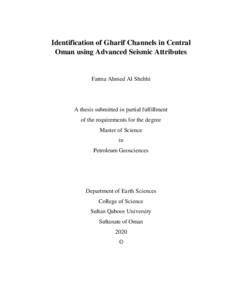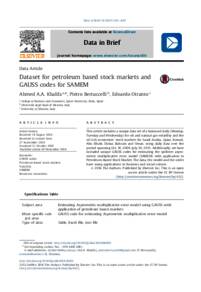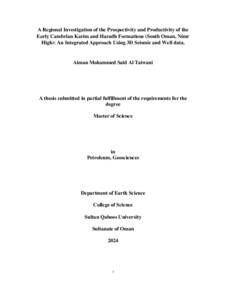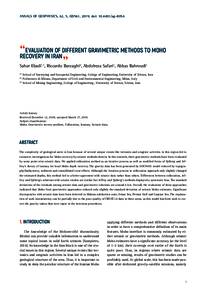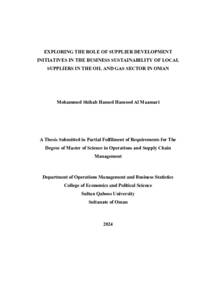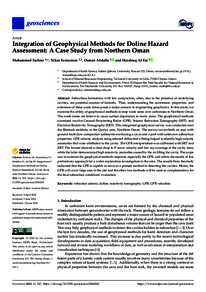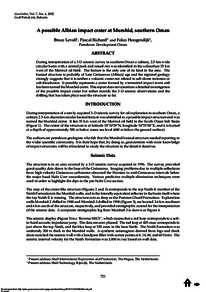Document
Identification of Gharif channels in central Oman using advanced seismic attributes.
Publisher
Sultan Qaboos University.
Gregorian
2020
Language
English
English abstract
Oil and gas industry nowadays heads towards complex reservoirs. This study aimed at
predicting Upper Gharif channels in Central Oman by discriminating sand from shale.
Two main approaches were followed: a) establishing Rock Physics Modelling (RPM)
relationships via well data: Density- P-wave Velocity – Shear-wave Velocity (Rho-VpVs) and recognizing separate models for the reservoirs and non-reservoirs, and b)
advanced seismic attributes such as Spectral Decomposition (Fast Fourier Transform
(FT), Continuous Wavelet Transform (CWT), Shell Spectral Decomposition (SSD)) and
Artificial Neural Network (ANN)-based attributes. Density-P-wave Velocity (Rho (Vp))
relationship suggests that the Middle Gharif clastics differ from Upper and Lower Gharif.
This hints at the alteration in sediments source, mineralogy, depositional environment
and/or other geological factors. Density-Porosity (Rho (φ)) marks possible variant pore
types and factors (diagenetic, local facies changes for example) in Upper and Middle
Gharif. RPM scenarios concluded that Acoustic Impedance (AI) and synthetic seismic
trace suggest dimming features indicating Gharif sand bodies (high AI). Far Stack seismic
reflectivity at Θ=35o
is tested for sand-shale discrimination and showed dimming in
relation to Near Stack seismic reflectivity at Θ=0°. Advanced seismic attributes clearly
indicate the Upper Gharif channel belts (anastomosing) as dimming features running
mainly in E-W orientation in line with channel geological depositional model. For
example, Fast Fourier Transform (FT) map of 40Hz at 15ms below Upper Gharif event,
Artificial Neural Network (ANN)-based confidence map and Shell Spectral
Decomposition images extracted 5ms and 10ms below Upper Gharif event showed the
complex Gharif channel pattern in study area. Gamma Ray response character supports
the depositional environments interpretations i.e. fluvial point bar (ZL-25H1), flood plain
(FWRN-2H 2 and AFL-1H1) and a crevasse splay (HSR-3H1), which were interpreted
through the dimming and brightening features seen from the 40Hz FT (15ms below Upper
Gharif event).
Member of
Resource URL
Arabic abstract
تتجه صناعة النفط والغاز هذه الأيام نحو الخزانات المعقدة، ولهذا تهدف هذه الدراسة إلى التنبؤ بقنوات غريف الع ليا في وسط عمان عن طريق التمييز بين الحجر الرملي والحجر الصخري. تم إتباع طريقتين رئيسيتين، هما: أ( تأسيس عالقات نمذجة فيزياء الصخور (RPM )عبر بيانات البئر؛ مثل: الكثافة Rho ،وسرعة الموجة الأولية wave-P ،وسرعة موجة القص -Shear wave( Vs-Vp-Rho )والتعرف على نماذج منفصلة للخزانات وغير الخزانات، ب( السمات الزلزالية ال متقدمة مثل التحلل الطيفي: تحويل فورييه السريع (FT ،(تحويل المويجات المستمر (CWT ،(تحلل مويجات شل (SSD ،(والسمات المعتمدة على الشبكة العصبية الأصطناعية based)-ANN .(تشير العالقة بين الكثافة والسرعة في الموجة الأولية (Vp (Rho إلى تاتية أن المواد الف في وسط غريف تختلف عن الجزء العلوي والسفلي. هذا يشير إلى التغيير في مصدر الرواسب، التركيبة المعدنية، البيئة الترسبية و/ أو عوامل جيولوجية أخرى. تحدد عالقة المسامية مع الكثافة (φ (Rho أنواع وعوامل المسام المتغيرة غريف العليا والوسطى. خل (RPM (إلى المحتملة )تغيرات المنشأ والسحنات المحلية على سبيل المثال( في صت سيناريوهات أن المعاوقة الصوتية (AI Impedance Acoustic (والتتبع الزلزالي الصناعي يشيران إلى ميزات عتمة تدل على الأجسام o الرملية في غريف )AI عالية(. وتم اختبار الأنعكاس الزلزالي لـ Stack Far عند 35 = Θ لتمييز الحجر الرملي من الصخري مقارنة بالأنعكاسات الزلزالية Stack Near عند °0 = Θ .وتشير الخصائص الزلزالية المتقدمة بوضوح إلى وأظهر خف وتا ا مع نموذج أحزمة قناة غريف العليا )نمط مفاغرة( باعتبارها ميزات عتمة تمتد بشكل رئيسي في اتجاه شرقي-غربي تماشي الترسيب الجيولوجي للقناة. على سبيل المثال خريطة (FT (Transform Fourier Fastعلى تردد 40 هرتز في 15ms أسفل حدث غريف العلوي وخريطة الثقة المستندة إلى الشبكة العصبية الأصطناعية based)-ANN (وصور شل لتحليل الطيف المستخرجة ضمن 5ms و10ms أسفل حدث غريف العلوي أظهرت نمط قناة غريف المعقد في منطقة الدراسة. تدعم صفة استجابة Ray Gamma تفسيرات البيئات الترسبية، أي شريط منعطف النهر (25H1-ZL (وسهول الفيضان ) -FWRN 2H2و 1H1-AFL ) وشق النهر (3H1-HSR ،(والتي تم تفسيرها من خلال ميزات العتمة والأشراق المشهودة من (FT( على تردد 40 هرتز ) 15ms أسفل حدث غريف العلوي(.
Category
Theses and Dissertations

